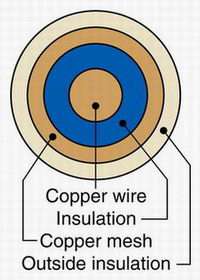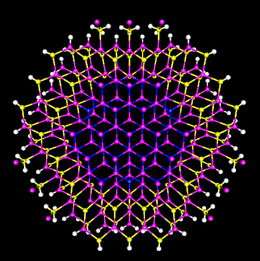April 23, 2007 feature
Nanoscale 'Coaxial Cables' for Solar Energy Harvesting

Scientists have designed a new type of nanowire – a tiny coaxial cable – that could vastly improve a few key renewable energy technologies, particularly solar cells, and could even impact other cutting-edge, developing technologies, such as quantum computing and nanoelectronics.
The nanowire, developed by researchers from the National Renewable Energy Laboratory (NREL) and Lawrence Berkeley National Laboratory, may solve several problems currently associated with renewable energy applications.

One overarching problem is that current semiconducting materials with the potential for use in renewable energy devices lack one key characteristic. When electrons in these materials are excited by light and jump to higher energy levels (leaving vacancies, known as “holes,” in the lower levels), both the electrons and the holes typically move around in the same region. Thus, they tend to recombine. This is desirable for certain applications, such as light-emitting devices, where electron-hole recombination produces light, but is not ideal for renewable energy devices. A better scenario is the separation of the excited electrons from the holes such that, in the case of solar cells, for example, the electrons can be drawn off and used for electricity.
“Our nanowires were designed to provide this feature, along with a superior electrical conductivity,” said NREL materials scientist Yong Zhang, the study's corresponding researcher, to PhysOrg.com. “Both of these properties are critical in order for renewable energy devices to reach their ultimate efficiency limits.”
Conventional coaxial cables consist of a central copper wire symmetrically surrounded by a braided copper conductor, with an insulating spacer material between the two. The braid serves as a return route for electrons that have already passed down the core wire; it can equally be viewed as a channel for holes moving in the opposite direction. The insulator separates the charge passing through the wire and braid.
Mimicking this structure, the group designed a nanoscale version consisting of a central wire, the “core,” surrounded by a shell (the shell is not cylindrical like conventional cables, but rather is hexagonal). The researchers used two semiconducting materials: gallium nitride (GaN) and gallium phosphide (GaP). They made two samples, one with a GaN core and GaP shell, and another with a GaP core and GaN shell. Both wires are approximately four nanometers in diameter (according to Zhang, this particular size was chosen by considering the computational effort needed to analyze the wires' properties, because larger wires, while easier to make, require considerably more computing power and time to model. Similar success, he says, could be achieved with nanowires up to 10-15 nanometers in diameter). In neither sample is an insulating spacer required. This phenomenon is the result of the specific semiconducting behaviors of GaN and GaP.
GaN and GaP, like all semiconductors, are classified by “band gap” – how much energy is required for electrons in the material to jump from the top of the “valence band,” a range of energies for which they don't participate in conduction, to the bottom of the “conduction band,” a range for which they do participate. When GaN and GaP are combined into a wire, the structure as a whole assumes its own band gap, which is very different from that of either component but much more appropriate for solar energy applications.
Besides providing efficient charge separation, the design may be able to remedy several shortcomings of solar-energy applications. For example, they could help widen the coverage of the solar spectrum and minimize energy loss associated with electron-hole recombination.
“We can tailor the properties of these cables to address the specific problems associated with each application,” said Zhang. “Beyond renewable energy applications, they could have exciting uses ranging from quantum computing to nanoelectronics.”
This research is described in detail in the April 5, 2007, online edition of Nano Letters.
Citation: Yong Zhang, Lin-Wang Wang, and Angelo Mascarenhas, “'Quantum Coaxial Cables' for Solar Energy Harvesting.” Nano Lett. ASAP Article, DOI: 10.1021/nl070066t
Copyright 2007 PhysOrg.com.
All rights reserved. This material may not be published, broadcast, rewritten or redistributed in whole or part without the express written permission of PhysOrg.com.





















